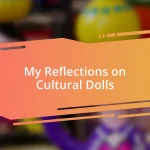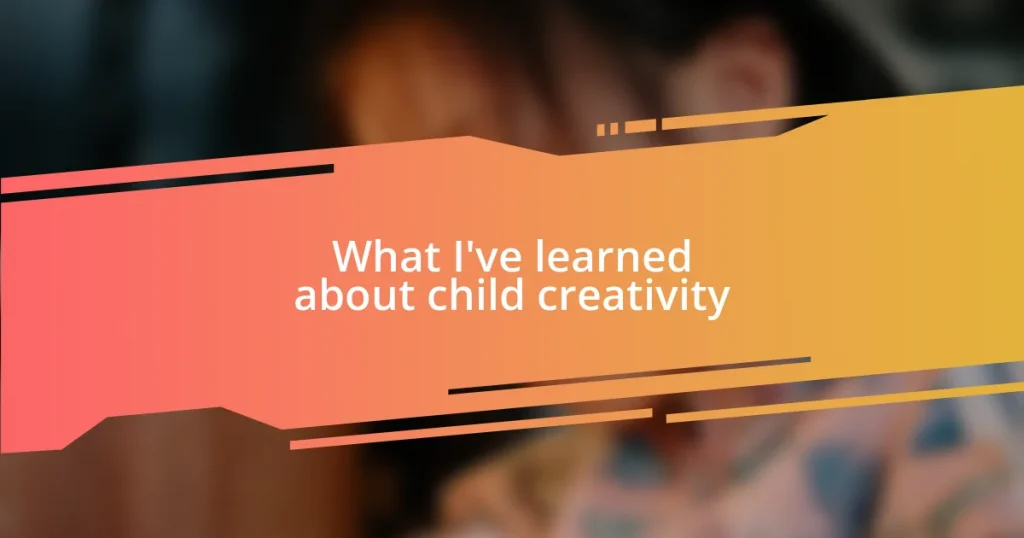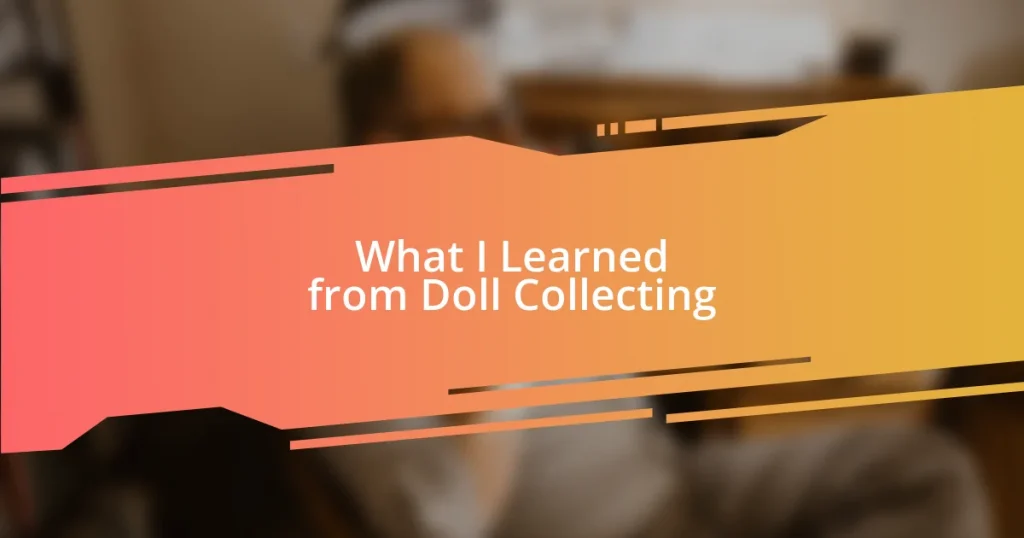Key takeaways:
- Child creativity thrives in environments without rigid rules, allowing for exploration and innovation.
- Nurturing creativity boosts problem-solving skills, emotional development, and resilience in children.
- Overcoming barriers such as self-criticism and fostering collaboration enhance children’s creative expression.
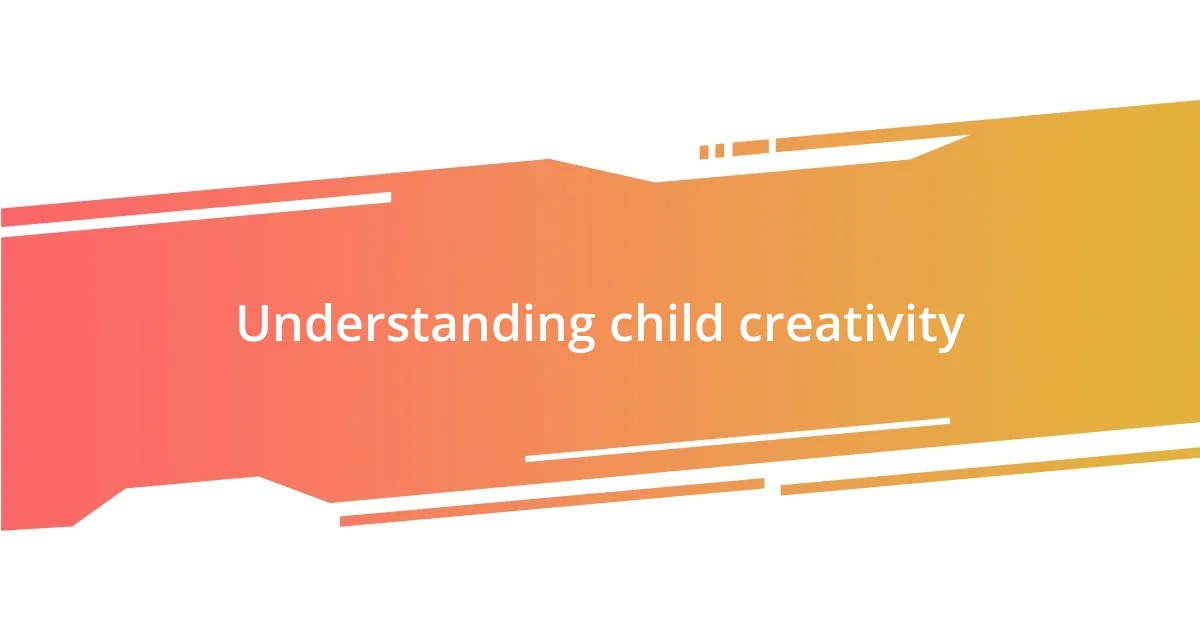
Understanding child creativity
Understanding child creativity goes beyond just recognizing it as an ability; it’s about seeing it as a vital form of expression. I remember watching my nephew spend hours transforming simple cardboard boxes into elaborate castles. His imagination didn’t just create play; it told stories, forming a rich tapestry of adventure that made me ponder: how often do we stifle that same creativity in adults?
The amazing thing about children is that their creativity often flourishes in environments where there are no rigid rules. I once facilitated a workshop for kids, where I encouraged them to create art from recycled materials. The joy and freedom they displayed made me realize that when children are given the space to explore, their creativity can blossom in unexpected ways. Isn’t it fascinating how a simple change in environment can unleash a world of ideas?
I’ve also observed that child creativity often involves an intuitive mix of emotion and logic. My daughter once crafted a puppet show to convey her feelings about a recent move, combining humor and heartache. It made me reflect on how deeply intertwined our emotional experiences are with the creative process. Don’t you think it’s this emotional depth that makes children’s creative expressions so genuine and impactful?
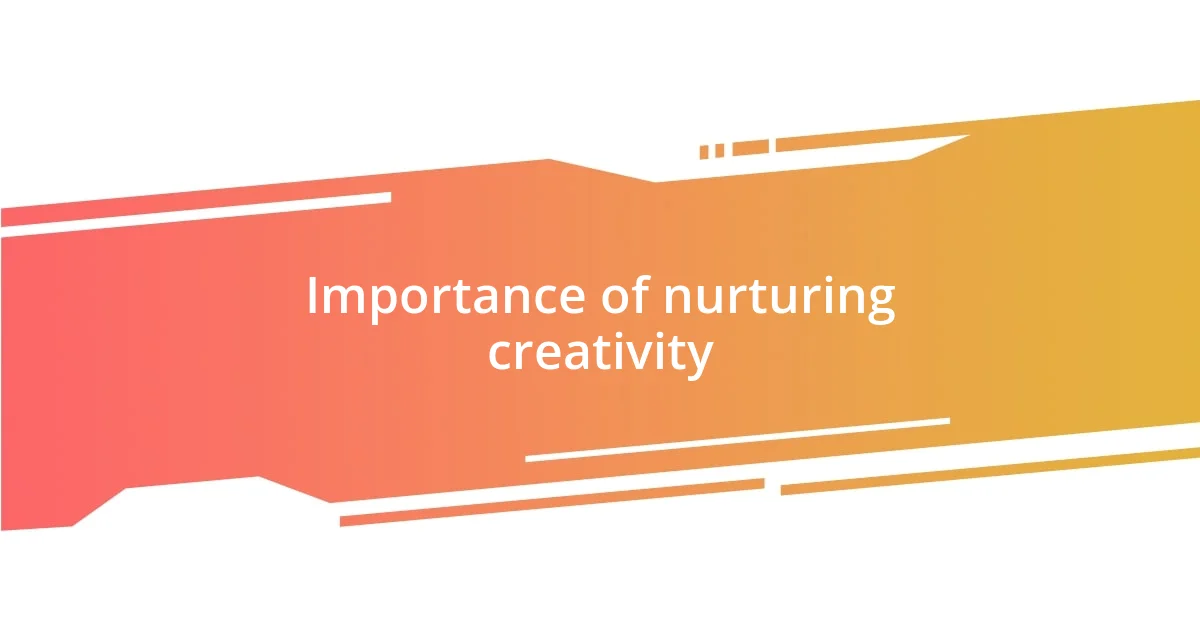
Importance of nurturing creativity
Nurturing creativity in children is essential because it provides them with a safe outlet for self-expression. I remember a time when I encouraged my son to sketch his dreams. Watching him unleash vibrant colors on the canvas while sharing whimsical stories was incredibly rewarding. It not only boosted his confidence but also strengthened our bond, as I was able to glimpse his inner world.
Here are a few key benefits of nurturing creativity in kids:
- Boosts Problem-Solving Skills: Creative activities allow children to think outside the box, equipping them with innovative problem-solving strategies.
- Enhances Emotional Development: Engaging in creative play helps kids process their emotions, giving them a healthy way to express what they feel.
- Fosters Resilience: Creativity encourages risk-taking; children learn that it’s okay to make mistakes, which builds their resilience for future challenges.
In every art project or imaginative story, I see the potential for young ones to learn not just about their creativity, but about themselves. Recognizing and nurturing that potential is an investment in their future.

Techniques to foster creative thinking
When it comes to fostering creative thinking, it’s essential to provide a space where imagination can run wild. One technique I’ve found particularly effective is engaging in open-ended play. I once set up a makeshift theater with my daughter and her friends. They transformed the living room into a vibrant stage, where they could be anything from animals to superheroes. The magic happened when I stepped back, allowing them to lead. I saw them invent new narratives and collaborate in ways I hadn’t expected. It’s astonishing how empowering kids can spark creativity just by removing the constraints.
Another technique involves blending different art forms. I recall a delightful afternoon where we combined painting with music. I played an eclectic mix of tunes while my son splashed colors onto paper, each brush stroke dancing to the rhythm. This not only challenged his creative thinking but also deepened his emotional connection to the art. Isn’t it intriguing how different forms of expression can inspire one another? Such experiences can cultivate an appreciation for the richness of creativity in various contexts.
Lastly, providing choices is crucial. I learned this when I presented my kids with various materials for a craft project—paper, fabric scraps, and eco-friendly items. Their eyes lit up with possibilities, leading to unique creations I never could have imagined. How often do you see children thrive when given the freedom to choose? It’s fascinating to witness them take ownership of their projects, turning simple materials into works of art that reflect their identities.
| Technique | Description |
|---|---|
| Open-Ended Play | Encourages imagination by allowing children to create narratives and scenarios without limitations. |
| Blending Art Forms | Combines different expressions like music and painting, enhancing emotional engagement and creative thought. |
| Providing Choices | Empowers children by letting them choose materials, fostering ownership of their creative projects. |

Role of play in creativity
Play serves as an important catalyst for creativity in children. I vividly remember a sunny afternoon when my niece and I ventured outdoors. Armed with nothing but a pile of leaves, she envisioned a whole pet shop, populating it with “exotic creatures” and creating imaginative backstories for each. Watching her dive into that world of make-believe made me realize how essential such unstructured play is. It allows kids to merge reality with fantasy, sparking their imagination in ways that structured activities often can’t.
Moreover, engaging in various forms of play helps children explore different perspectives and roles. I once set up a mini grocery store in our playroom. Each time my son played the cashier, I could see him mimic adult behaviors while processing social interactions. It struck me then how play mimics real-life scenarios, giving them the chance to learn about responsibility, empathy, and resourcefulness. How often do we underestimate the power of simple role-playing?
As I reflect on these experiences, it’s clear that play does not just stimulate creativity; it nurtures emotional intelligence too. During a play session, when my daughter pretended to be an astronaut, she expressed both excitement and fear about venturing into the unknown. It was a precious moment, revealing how play serves as a safe space for children to navigate complex feelings. Do you ever wonder how much children can reveal through their playful antics? Engaging in these playful moments can offer profound insights into their thoughts and emotions, showcasing their creative spirit in a beautifully unfiltered way.

Encouraging creative expression in children
Creating an environment that encourages creative expression in children is something I’ve always prioritized. One afternoon, I decided to turn our kitchen into an art studio. I laid out a variety of drawing materials—crayons, colored pencils, and even some unconventional items like coffee filters and spices. The joy in my children’s eyes as they experimented with colors and textures was palpable. By giving them the freedom to explore, I observed how their creativity flourished in unexpected ways. Isn’t it rewarding to see how simple tools can ignite such imaginative thinking?
Encouraging creative expression can also mean embracing the messiness that comes with it. I remember a time when my son wanted to bake a cake but with an artistic twist. Instead of following a traditional recipe, we used vibrant food coloring and edible glitter. The kitchen soon transformed into a colorful chaos, and it was a beautiful mess. Watching him delight in the process made me appreciate the power of creative freedom. How many of us are hesitant to let our kids break a few rules? Sometimes, stepping outside the conventional boundaries can lead to the most memorable experiences.
Another strategy that has worked wonders for me is storytelling. One evening, my daughter and I cuddled up with a pile of books, but instead of reading, we began crafting our own tales. With her wild imagination, we came up with stories about a cat who became a knight or a dragon who loved to paint. Seeing the excitement on her face as she narrated her creations was a reminder of how impactful storytelling can be. Have you ever noticed how stories can spark a child’s creativity? Encouraging them to weave narratives not only nurtures their imagination but also fosters communication skills that are beneficial in countless ways.
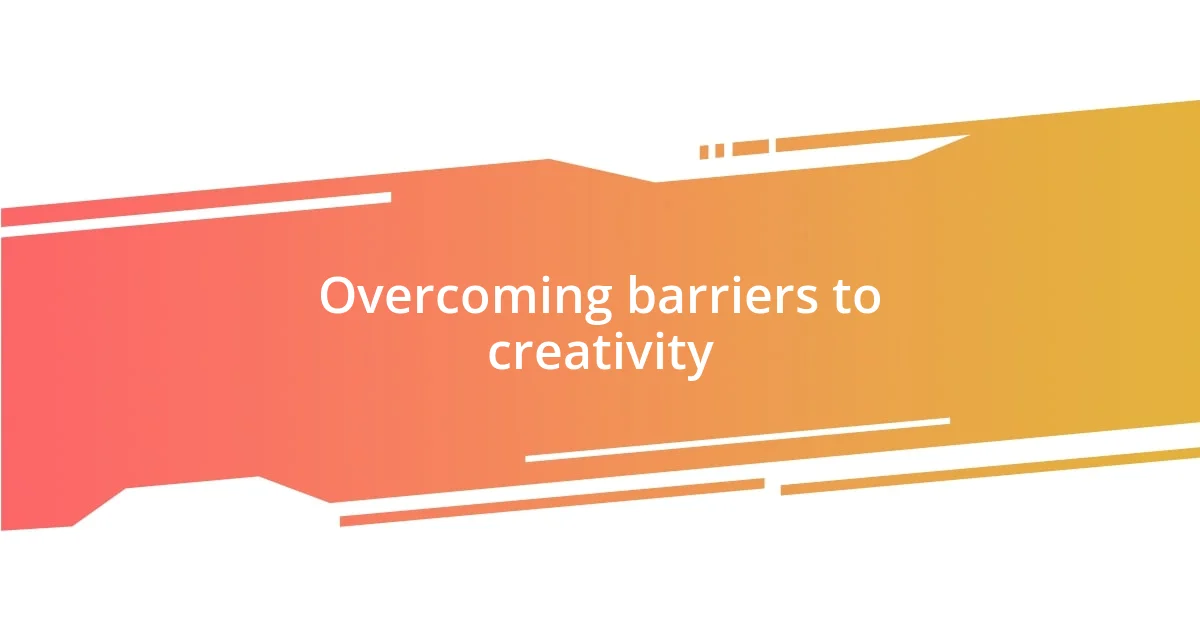
Overcoming barriers to creativity
Overcoming barriers to creativity often means addressing the pressures that can stifle children’s natural instincts. One day, I observed my daughter hesitating to share a drawing she’d just completed, worried it wouldn’t be “good enough.” It struck me then how harsh self-criticism can diminish the joy of creative expression. Encouraging a supportive environment where mistakes are celebrated instead of frowned upon can be a game changer. Have you ever noticed how often we let our inner critic take the stage?
To further dismantle these barriers, I’ve found that fostering collaboration can work wonders. I recall a time when my kids teamed up for a puppet show project. They crafted their puppets from socks and paper bags, and I was amazed at how their ideas bounced off each other like a lively game of catch. The process not only sparked their creativity but also strengthened their bond. Isn’t it enlightening to see how teamwork can fuel innovation?
Lastly, I believe that exposing children to diverse experiences allows them to break free from their creative constraints. I once took my son to a local art fair, where we marveled at everything from abstract sculptures to vibrant paintings. His eyes lit up with inspiration, and that’s when I realized the importance of input in creative output. What if we made it a habit to introduce children to different art forms, cultures, and ideas? It’s incredible how exposure can expand their creative horizons and lead to unique expressions of their imagination.
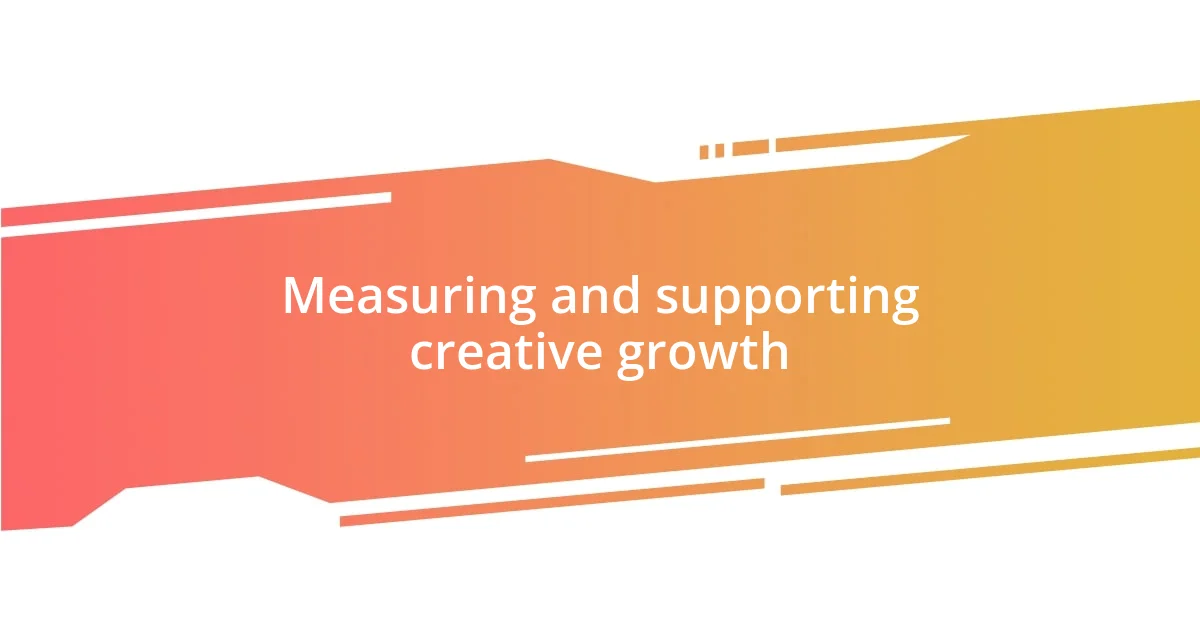
Measuring and supporting creative growth
Measuring creative growth in children can be a nuanced process, and I’ve often relied on keen observation as my primary tool. For instance, when my daughter started doodling on her homework, I didn’t see it as a distraction; rather, I viewed it as an indication of her evolving imagination. Have you ever noticed how children express their thoughts through art? That’s creative growth staring you in the face, waiting to be nurtured.
Supporting this growth means encouraging risk-taking in their creative endeavors. I remember when my son decided to mix all his paint colors into one chaotic masterpiece instead of sticking to traditional hues. At first, I was taken aback by the muddy blend, but then I learned to appreciate his willingness to experiment. What if we celebrated those seemingly “failed” attempts as vital steps in their creative journey? It’s about shifting our focus from the final product to the delightful process of exploration.
Finally, I believe in keeping a creative journal for my children as a tangible way to track their artistic evolution. This practice not only captures their progress but also serves as a cherished memory book. Imagine flipping through pages filled with their ideas, doodles, and stories! Isn’t it fascinating to see how their styles and themes evolve over time? This method not only supports their creative expression but also instills a sense of pride in their artistic journey.






